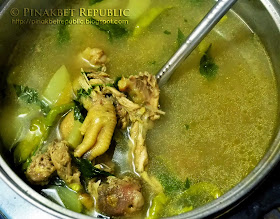 |
| Lauya/tinola a kamanokan a nalaokan iti papaya ken bulong sili. |
Now that the kamanokan (native free range chicken) is prepared (butchered, dressed, cut and cleaned), here's one most popular dish we can turn a kamanokan into a very savory and sumptuous soup: tinola or lauya with a variety of obligatory veggies like green papayas, sayote, tabungaw, kabatiti, etc. and various leaves of which sili, paria and marunggay are the most preferred.
First thing, sauté the chicken cuts in little cooking oil and lots of garlic, onions and ginger. Stir fry the meat in high heat until it turns brown and its natural oil oozes out and its distinct kamanokan aroma steaming and wafting garlicky and most of all gingerly. You can season and spice it at this juncture, add some salt or teaspoons of patis, a pinch of cracked black pepper. For a uniquely Ilokano zest and aroma, stir fry it with bugguong juice.
Done stir frying. The meat is melting with chicken and spicy goodness, its fragrance overwhelming the whole kitchen and its heavenly scent whiffing outside tantalizing neighbors' jealous noses. Now, pour in a couple of cup or so of water and season more to taste:
Let it simmer in moderate heat
My favorite tinola parts are here, all bony but the most tasty and delicious of all manok master pieces: ulo (sucking out the mata and the utek is not sacrilegious at all but religious), tengnged, payak, paragpag, kimmol, saka/karaykay...
The papaya is sweet, I prefer sligthly ripened papaya for most of my tinolas as I love the sweet pulpiness of the papaya. The sili leaves and fruit is just as aromatically good. Sometimes, I add but paria leaves just for the scandalously exquisite bitter soup it imparts to tease and please an Ilokano palate in me.
:::::
More on native chicken:




























